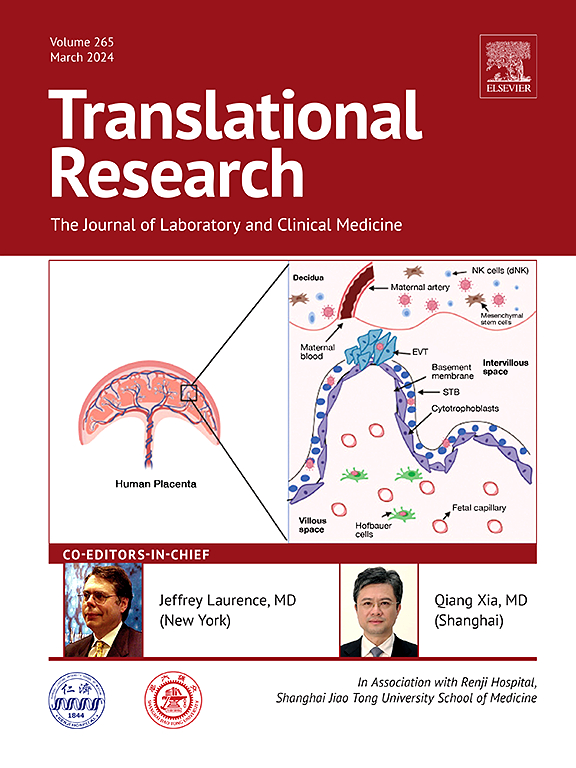RXRα/MR信号通过促进肾小管上皮细胞衰老和代谢重编程,促进糖尿病肾病的发生。
IF 5.9
2区 医学
Q1 MEDICAL LABORATORY TECHNOLOGY
引用次数: 0
摘要
细胞衰老和代谢重编程是糖尿病肾病(DKD)的重要特征。然而,细胞衰老和新陈代谢重编程之间的内在机制尚不明确。在这里,我们报告了视黄醇X受体α(RXRα)--一种关键的核受体转录因子--调节DKD中的细胞衰老和代谢重编程。通过高通量测序、生物信息学分析和实验验证,我们证实了RXRα在脂质超载诱导的肾小管上皮细胞(RTECs)衰老和代谢紊乱中的关键作用。在体内,向肾脏原位注射 AAV9-shRxra 可减少 DKD 小鼠的蛋白尿、肾小管上皮细胞衰老和胰岛素抵抗。在体外,敲除 RXRα 能明显改善 G2/M 期停滞并抑制衰老相关分泌表型(SASPs)的表达。蛋白质-蛋白质相互作用(PPI)分析和无偏见生物信息学被用来确定RXRα和矿质皮质激素受体(MR)之间的直接相互作用,随后通过共沉淀进行了验证。基因网络分析揭示了RXRα和MR在RTECs衰老过程中的协同调控作用。在加速衰老小鼠模型中,MR拮抗剂抑制了RXRα/MR信号传导,改善了RTECs衰老,减少了肾脏间质纤维化和脂质沉积。这些发现表明,抑制 RXRα/MR 信号传导可缓解代谢紊乱过程中的细胞衰老。因此,我们的研究揭示了RXRα/MR信号转导是介导细胞衰老和代谢重编程之间串扰的关键调控因子,为靶向DKD中的细胞衰老和代谢失调揭示了一种新的机制。本文章由计算机程序翻译,如有差异,请以英文原文为准。
RXRα/MR signaling promotes diabetic kidney disease by facilitating renal tubular epithelial cells senescence and metabolic reprogramming
Cell senescence and metabolic reprogramming are significant features of diabetic kidney disease (DKD). However, the underlying mechanisms between cell senescence and metabolic reprogramming are poorly defined. Here, we report that retinoid X receptor α (RXRα), a key nuclear receptor transcription factor, regulates cell senescence and metabolic reprogramming in DKD. Through high-throughput sequencing, bioinformatic analysis and experimental validation, we confirmed the critical role of RXRα in promoting cell senescence and metabolic dysregulation in renal tubular epithelial cells (RTECs) induced by lipid overload. In vivo, in situ injection of AAV9-shRxra into the kidney reduced proteinuria, RTECs senescence and insulin resistance in DKD mice. In vitro, knockdown of RXRα markedly improved G2/M phase arrest and suppressed the expression of senescence-associated secretory phenotypes (SASPs). Protein-protein interaction (PPI) analysis and unbiased bioinformatics were employed to identify the direct interactions between RXRα and the mineralocorticoid receptor (MR), which were subsequently validated through coimmunoprecipitation. Gene network analysis revealed the collaborative regulatory role of RXRα and MR in RTECs senescence. In an accelerated aging mouse model, treatment with a MR antagonist has been shown to inhibite the RXRα/MR signaling, improve RTECs senescence, and reduce interstitial fibrosis and lipid deposition in the kidneys. These findings indicate that inhibition of RXRα/MR signaling could alleviate cell senescence during metabolic disorders. Thus, our study revealed that RXRα/MR signaling serves as a critical regulatory factor mediating the crosstalk between cell senescence and metabolic reprogramming, shedding light on a novel mechanism for targeting cell senescence and metabolic dysregulation in DKD.
求助全文
通过发布文献求助,成功后即可免费获取论文全文。
去求助
来源期刊

Translational Research
医学-医学:内科
CiteScore
15.70
自引率
0.00%
发文量
195
审稿时长
14 days
期刊介绍:
Translational Research (formerly The Journal of Laboratory and Clinical Medicine) delivers original investigations in the broad fields of laboratory, clinical, and public health research. Published monthly since 1915, it keeps readers up-to-date on significant biomedical research from all subspecialties of medicine.
 求助内容:
求助内容: 应助结果提醒方式:
应助结果提醒方式:


